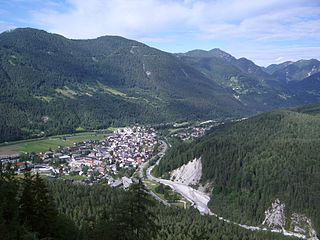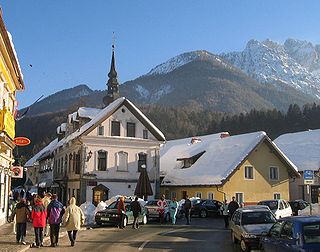Log, LOG, or LoG may refer to:

Kranjska Gora is a town in northwestern Slovenia, on the Sava Dolinka River in the Upper Carniola region, close to the Austrian and Italian borders. It is the seat of the Municipality of Kranjska Gora.

The Sava Dolinka is a headwater of the Sava River in northwestern Slovenia. The 45 kilometres (28 mi) long Sava Dolinka starts as Nadiža Creek in the Planica Valley under Mount Zadnja Ponca in the Julian Alps, at an elevation of 1222 m, close to the Italian border. The stream goes underground soon after its source and breaks out again after 5 km at an elevation of 842 m in Zelenci, near Kranjska Gora. The Sava Dolinka flows through Kranjska Gora, Gozd Martuljek, Jesenice, between Bled and Breg, and past the town of Lesce. The first in a series of hydroelectric power plants on the river, the Moste Hydro Power Plant, is located near Žirovnica. It merges with the second major headwater of the Sava, the Sava Bohinjka, at Radovljica. A notable tributary of the Sava Dolinka is the Radovna, which flows through the Vintgar Gorge near Bled.
Aleš Gorza is a retired Slovenian alpine skier.

Podkoren is a settlement in the Municipality of Kranjska Gora in the northwestern Upper Carniola region of Slovenia.

Belca is a settlement in the Municipality of Kranjska Gora in the Upper Carniola region of Slovenia.

Srednji Vrh is a settlement in the Municipality of Kranjska Gora in the Upper Carniola region of Slovenia.

The Russian Chapel on the Vršič Pass is a Russian Orthodox chapel located on the Russian Road on the northern side of the Vršič Pass in northwestern Slovenia. The chapel, dedicated to Saint Vladimir, was built by Russian prisoners of war engaged in forced labor in the area during World War I. It serves as both a war memorial and a symbolic link between Slovenia and Russia.

The Nadiža is a mountain stream near the town of Kranjska Gora, in the far northwestern corner of Slovenia. Springing from a bare rockface on the eastern slope of Mount Zadnja Ponca above the Tamar Valley in the Julian Alps, it is the first source of the Sava Dolinka River, the longer of the two sources of the Sava, the longest Slovene river at 221 km (137 mi) and a tributary of the Danube.

Kranjska Gora Ski Resort is an old Slovenian ski resort located in seven different areas in Municipality of Kranjska Gora. In the Upper Carniola region, the nearest city is Jesenice and it is about an hour away from Ljubljana.
The 1999–2000 Slovenian Ice Hockey League was the ninth season of the Slovenian Hockey League. Olimpija have won the league championships.
The 2000–01 Slovenian Ice Hockey League was the 10th season of the Slovenian Hockey League. Olimpija won the league championships.
The 2003–04 Slovenian Ice Hockey League was the 13th season of the Slovenian Hockey League. Seven teams participated in the league, and Olimpija have won the league championships.
Hokejski klub Kranjska Gora, commonly referred to as HK Kranjska Gora or simply Kranjska Gora, was an ice hockey team from Kranjska Gora, Slovenia. The club played in both the Yugoslav Ice Hockey League and the Slovenian Hockey League.

The Heathen Maiden is a rock formation that resembles a female human face. It can be seen in the northern face of Mount Prisojnik near Kranjska Gora, in the Julian Alps in northwestern Slovenia. It is associated with a legend about a chamois known as Goldenhorn and a nymph (vila) dwelling in the mountain.
Klemen Kosi is a World Cup alpine ski racer from Slovenia.
Settlements, within municipalities in Slovenia, and sometimes called Log include:

Ženski košarkarski klub Kranjska Gora – Jesenice is a Slovenian women's basketball club from Kranjska Gora.
Slovenia sent competitors to the 2018 Winter Paralympics in Pyeongchang, South Korea. One para-alpine skier was named Jernej Slivnik is on the team. He is a 16-year-old who had an injury a few months before the Winter Games started. He is coached by Roman Podlipnik. While he was named to the team in 2017, he met all the criteria to compete at the Games in January 2018.














